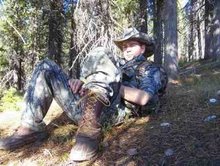Elk Hunting in Virginia
For the last several years this has really bothered me and I have kept my mouth shut about this issue! By all means I believe that each state has the right to make their own choices in regards to game management! That being said as a citizen of the Commonwealth of Virginia, I am entitled to my own private opinion about those decisions that are made! I personally think that this decision stinks! Elk once roamed the mountains of Virginia as a wild and free species and I believe that if we allow the herd to grow it will provide tourism dollars to the counties in the area where the elk are, hunting opportunities when the herd is strong enough to support it, and opportunities for revenue for Virginia to support the management of that herd. We should embrace these animals and allow them continue to grow and develop. If you are a Virginia sportsman or Sportswoman please contact the VDGIF and let them know how you feel and contact your Virginia state representatives as well.
Apparently Others feel the same way!
Commentary in the Fredericksburg, VA Free Lance Star
Elk Hunting in Virginia

Where are the elk in Virginia?
Most free-roaming elk in Virginia emigrated from eastern Kentucky, where Kentucky DNR has released them since 1998. There are only a few elk in Virginia, so your chances of seeing elk are not high. However, the closer you are to Kentucky, the greater the probability of encountering elk. All known elk harvests in recent years have been in Wise County.
How many elk did Virginia hunters take last hunting season?
Hunters harvested two elk in Virginia during the 2004-2005 hunting season and eight elk during the 2003-2004 hunting season. Total harvests by county since the 2000-2001 hunting season are:
| County | Elk Harvested |
|---|---|
| Buchanan | 2 |
| Bland | 0 |
| Dickenson | 0 |
| Lee | 0 |
| Russell | 3 |
| Scott | 3 |
| Smyth | 0 |
| Tazewell | 0 |
| Washington | 1 |
| Wise | 16 |
What is the best place to hunt elk in Virginia?
Most elk occur in the Kentucky border area. Much of southwestern Virginia is privately owned and if you have friends or relatives near Kentucky, you may want to check with them about opportunities for elk hunting on private land.
There are two public hunting areas on the Kentucky border. The first of these is the Clinch Ranger District of the Jefferson National Forest (276-328-2931). Clinch Ranger District is mostly in Wise County, with portions in Scott, Lee, and Dickenson counties. The second public hunting area is the Flanagan Reservoir in Dickenson County, managed by the U.S. Army Corps of Engineers (276-835-9544). Call these land management offices for maps and recommendations on accommodations in the respective communities.
Can antlerless elk be taken in areas where hunters are allowed to take only antlered white-tailed deer?
Yes!
Do harvested elk have to be checked-in?
What tags do I use?
Can I quarter the elk before moving it from the kill location?
Yes, a successful hunter must check an elk, just as you must check-in a white-tailed deer. You validate a deer tag on your Big Game before moving the carcass from the kill location. Elk must be checked in at a check station and cannot be checked by phone. You may dismember an elk to get it out of the woods, but do not destroy the sexual identity of the animal.
Why does Virginia allow elk hunting?
For the past several years, the state of Kentucky has undertaken an ambitious elk restoration program in southeastern Kentucky, which has resulted in a population of over 4,000 animals in Kentucky. The Kentucky elk restoration area borders Virginia in Buchanan, Dickenson, Wise, and Lee counties. Over the past several years, several of these elk have moved into Virginia, and capturing and returning these elk to Kentucky has not proved to be a practical management option. Therefore, as a proactive management option designed to keep these elk from becoming established in Virginia at this time, the VDGIF has established a full season either-sex elk hunt to run concurrent with all open deer seasons.
Why does Virginia want to keep elk from being established at this time?
One of the primary reasons the Department has been opposed to elk restoration is the potential for transmission of diseases to our valuable white-tailed deer herd. A serious disease that could be introduced by elk is Chronic Wasting Disease (CWD). To date, the disease has only been found in cervids (members of the deer family) in North America. CWD is a contagious neurological disease affecting deer and elk. It causes a characteristic spongy degeneration of the brains of infected animals resulting in emaciation, abnormal behavior, loss of bodily functions and death.
The movement of live animals is one of the greatest risk factors in spreading CWD into new areas. Natural movements of wild deer and elk contribute to the spread of the disease, and human-aided transportation of both captive and wild animals greatly exacerbates this risk factor. There are several potential routes for CWD infection of Virginia's white-tailed deer herd. One possible route is the movement of CWD-infected elk through state-sponsored elk restoration projects. Tennessee, North Carolina, and Kentucky have all released elk recently. Another possible route for CWD infection is through movement of elk and deer between deer farms in neighboring states. While Virginia has very restrictive regulations governing the possession and movement of captive cervids, several of our border states have many deer farms.
VDGIF is working to protect Virginia's hunting economy by taking every precaution to prevent CWD infection of our deer herd. Visit our Chronic Wasting Disease page for more information on VDGIF's effort to keep CWD out of Virginia.
